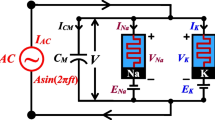Summary
We were able to simulate the Wenckebach phenomenon using a model of a one-dimensional cable, consisting of 20 serially connected Purkinje fiber cells represented by the model of McAllister, Noble, and Tsien. The internal resistance between the 10th and 11th cells was modified to five times the normal. To reconstruct the action potential, the derivative equation was solved using a fourth-order Runge-Kutta algorithm. When the first cell of the cable was stimulated, periodically, at an interval of 610ms, a 9:8 Wenckebach pattern was elicited in the conduction between the tenth and 11th cells. Lower order 5:4, 4:3, 3:2 Wenckebach patterns were observed at pacing cycle length of 605, 600—595, and 590—575 ms, respectively. At a pacing cycle length of 570ms or less, 2:1 block was elicited. In another simulation, only whenI Na was 0 could the Wenckebach phenomenon be elicited in a cable model, in which internal cell resistance and membrane capacitance were uniformly set, but in which theI Na of the center two cells of the cable were alternated between 1 and 0. A localized increase in internal resistance, a relatively long time constant of deactivation of the delayed rectifier outward current, and a relatively rapid rate of pacing cycle length was necessary to evoke the Wenckebach phenomenon. The conductance of the delayed rectifier current at the end of an action potential increased progressively, except after a dropped beat when it was allowed to decrease. It was concluded that the change of conductance affected the cable property of the fiber and consequently evoked the Wenckebach phenomenon.
Similar content being viewed by others
References
Decherd GM, Ruskin A (1946) The mechanism of the Wenckebach type of A-V block. Br Heart J 8:6–16
Rosenblueth A (1958) Mechanism of Wenckebach-Luciani cycles. Am J Physiol 194:491–494
Watanabe Y, Dreifus LS (1967) Second degree atrioventricular block. Cardiovasc Res 1:150–158
Roberge FA, Nadeau RA (1969) The nature of Wenckebach cycles. Can J Physiol Pharmacol 47:695–704
Nadeau RA, Roberge FA, Bhereur P (1969) The mechanism of the Wenckebach phenomenon. Israel J Med Sci 5:814–818
Paes de Carvalho A, de Almeida DF (1960) Spread of activity through the atrioventricular node. Circ Res 8:801–809
Wennemark JR, Kossmann CE (1970) Intraventricular block: physiologic considerations of clinical relevance. Adv Intern Med 16:59–80
Cranefield PF, Klein HO, Hoffman BF (1971) Conduction of the cardiac impulse. I. Delay, block, and one-way block in depressed Purkinje fibers. Circ Res 28:199–219
Greenspan K, Anderson GJ, Fisch C (1971) Electrophysiologic correlate of exit block. Am J Cardiol 28:197–200
Cranefield PF, Wit AL, Hoffman BF (1972) Conduction of the cardiac impulse. III. Characteristics of very slow conduction. J Gen Physiol 59:227–246
Watanabe Y, Dreifus LS (1972) Levels of concealment in second degree and advanced second degree A-V block. Am Heart J 84:330–347
Hoffman BF, Cranfield PF (1960) Electrophysiology of the heart. McGraw-Hill, New York, pp 32–174
Hoshino K, Anumonwo J, Delmar M, Jalife J (1990) Wenckebach periodicity in single atrioventricular nodal cells from rabbit heart. Circulation 82:2201–2216.
Fozzard HA (1979) Conduction of the action potential. In: Berne RM (ed) Handbook of physiology, section 2: the cardiovascular system, vol. I. American Physiological Society, Bethesda, pp 335–356
Schaffer AI, Depasquale NP (1973) Mechanisms of Wenckebach A-V block and the obligatory ventricular echo. Cardiovasc Res 7:696–702
Lieberman M, Kootsey MJ, Johnson EA, Sawanobori T (1973) Slow conduction in cardiac muscle. Biophys J 13:37–55
Guevara MG (1988) Spatiotemporal patterns of block in an ionic model of cardiac Purkinje fibre. In: Markus M (ed) Springer series in synergetics, vol. 39: from chemical to biological organization. Springer, Berlin, pp 273–281
McAllister RE, Noble D, Tsien RW (1975) Reconstruction of the electrical activity of cardiac Purkinje fibres. J Physiol (Lond) 251:1–59
Hodgkin AL, Huxley AF (1952) A quantitative description of membrane current and its application to conduction and excitation in nerve. J Physiol (Lond) 117:500–544
Weidmann S (1951) Effect of current flow on the membrane potential of cardiac muscle. J Physiol (Lond) 115: 227–236
Yanagihara K, Noma A, Irisawa H (1980) Reconstruction of sino-atrial node pacemaker potential based on the voltage clamp experiments. Jpn J Physiol 30:841–857
Hunter PJ, McNaughton PA, Noble D (1975) Analytical models of propagation in excitable cells. Prog Biophys Molec Biol 30:99–144
Author information
Authors and Affiliations
Rights and permissions
About this article
Cite this article
Tadehara, F., Yanagihara, K., Shigeto, N. et al. Mathematical simulation of the Wenckebach phenomenon in Purkinje fibers. Heart Vessels 14, 185–188 (1999). https://doi.org/10.1007/BF02482305
Received:
Revised:
Accepted:
Issue Date:
DOI: https://doi.org/10.1007/BF02482305




